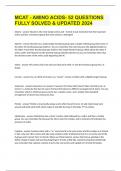Samenvatting
Summary 2.7c Problem 3 - Speecial treatment for a genious (Giftedness)
- Instelling
- Erasmus Universiteit Rotterdam (EUR)
This summary is everything you need to know about Problem 1 - Bullying. It includes in just 10 pages all the relevant information from the 4 sources given. Try it out and you won't regret it!
[Meer zien]













